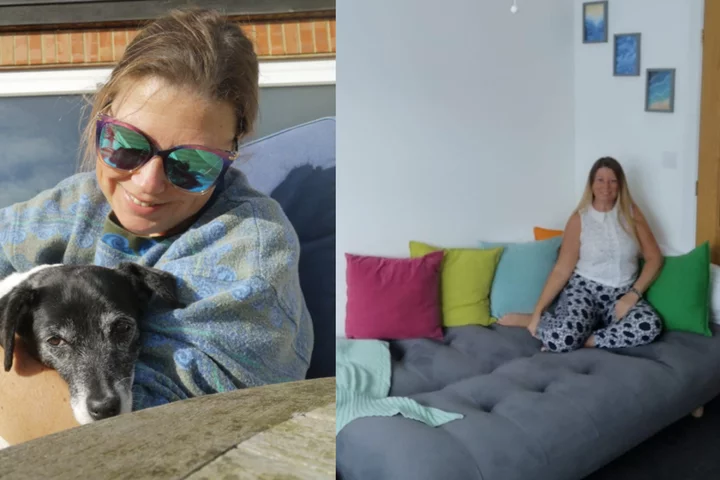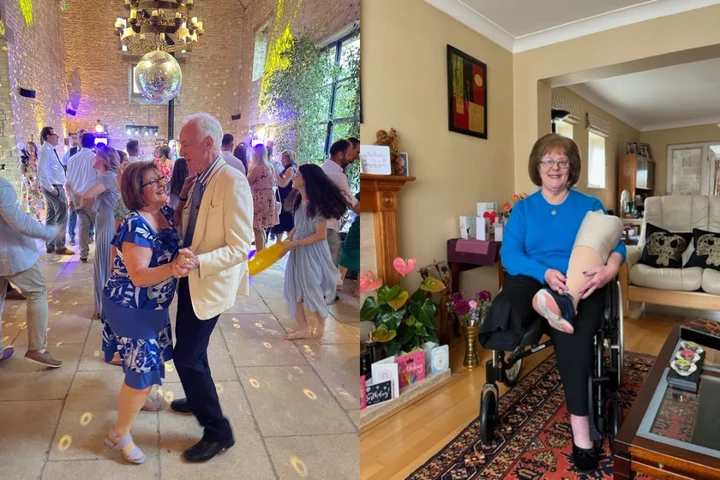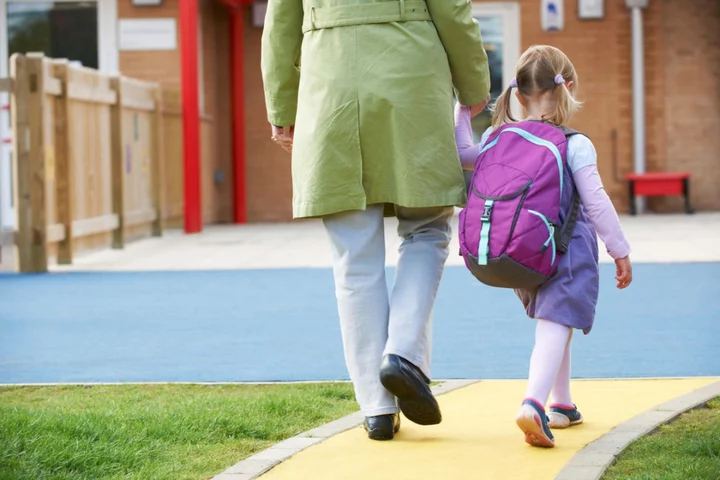
The most unhygienic things in your kitchen revealed – and how to get them clean
It’s likely there are countless things in your kitchen which look clean, but actually, they’re filthy. Could your dishcloths be making you sick? When was the last time you washed your tea towels? And do we really need to bleach the sink more than once a month? We asked an expert to find out. Knobs, door handles, and buttons The buttons and dials on your kitchen appliances could be a germ-fest. “People often neglect to clean these areas of the kitchen,” says Danielle Mason, a cleaning content creator – or ‘cleanfluencer’ – who creates tutorials and videos on TikTok and Instagram. “Most of the time, they don’t think it is important, but as you’re commonly handling raw meat and food, it’s extremely important to keep these areas clean, due to cross-contamination. “Always sanitise with a cloth – I like to do this with Zoflora, as it leaves a great smell afterwards, and kills bacteria from dirty fingers.” Cloths If what you clean with isn’t clean, chances are, your kitchen isn’t either. “I always leave my cloth to soak in bleach before going to bed every night,” says Mason. “This enables a new start in the morning with no bacteria. Also, make sure you’re replacing the cloths – I would suggest a new one every two weeks, whilst still bleaching every night. And make sure you’re not using this cloth on anything other than the kitchen, as you do not want to cross-contaminate.” Sponges Mason stresses sponges are unhygienic, as they’re constantly damp and can carry E. coli. “People tend not to use sponges, as they carry so many more germs, and even putting them in the microwave will not kill all of them. Avoid a sponge where possible.” Dish towels Dish towels and tea towels may not be changed anywhere near often enough. “You should have one for every day of the week, as they carry so many bacteria and germs, which get spread across the kitchen. If you’re drying pots and pans, and then wiping down your surfaces, it’s not good,” she says. Chopping boards Chopping boards – particularly wooden ones – could be a haven for bacteria. “You should have a different colour for different types of food, one for meat, fruit, and other foods,” advises Mason. “The best way to clean them is in a dishwasher, as it’s good to get rid of all the germs due to the very high heat. If you don’t like the dishwasher, then boil the kettle water and leave the chopping boards to soak in it. I use a steam cleaner on mine, as it kills 99.9% bacteria and there are no chemicals.” It is best to avoid wooden chopping boards altogether, as these cleaning methods may damage them. Kitchen sink “This is a massive breeder of bacteria and grime; a distinct microbiome is found in sinks. “The plumbing area found beneath sinks revealed microbial communities dominated by a group of bacteria called Proteobacteria. This phylum includes pathogens such as Salmonella and E. coli, which can cause serious disease,” Mason shares. “I’ve always been taught never to wash my hands in the sink, and to never throw dirty water down the sink. You wash your cups and plates in the sink and prepare food, so it should always be kept clean, and nothing from outside the kitchen should cross-contaminate that. For example, never wash your floors and put dirty water in your kitchen sink, always throw it down the toilet.” How do you possibly clean the inside of your sink and drains? “Baking soda and vinegar is the best way to clean your sink out, or bleach, but you must be careful with bleach, as it can stay in the bottom of your sink, depending on the material it’s made of. I clean my sink out every day.” Pipes and cupboards around your sink could be leading you to have a rodent problem. “You can prevent mice and rodents from entering the kitchen by covering any small crevices or cracks. It is also important to repair leaks as soon as they happen, as they can come through the pipes,” she says. Fridges “Deep clean [your fridge] every two months. A normal cleaning – the wiping of shelves – should be done every other day with soapy water. For any bad smells, use baking soda, which will absorb the smell from the fridge,” Mason continues. “The fridge is a breeding ground for salmonella, E. Coli and other bacteria.” Bins Where you throw your waste away could be a breeding ground for germs. “Make sure you keep [outdoor] rubbish bins away from your house, and make sure you empty your bin as soon as it’s full,” advises Mason. “I personally do not keep a bin in the kitchen, I use a bag and I take that out by the end of the day, but if you are using a bin, make sure you bleach it with hot kettle water, to keep it smelling fresh.” Read More Charity boss speaks out over ‘traumatic’ encounter with royal aide Ukraine war’s heaviest fight rages in east - follow live Laura Whitmore: I feel unsafe as a woman Meet the professional cuddler charging £70-an-hour to hug ‘the big spoons in life’ New warnings about ‘concerning’ rise in at-home cosmetic dentistry
2023-07-27 14:15

Future airplanes must meet stricter handicap standards, but not for years
Manufacturers and airlines now have more than a decade to make bathrooms large enough for wheelchair users on the most common type of airliners under a new Department of Transportation rule issued on Wednesday.
2023-07-27 04:52

Sarah Jessica Parker shares rare glimpse inside her family life: ‘We cook every night’
Sarah Jessica Parker has shared a rare glimpse inside her family life with husband Matthew Broderick. In a recent appearance on the Table for Two with Bruce Bozzi podcast, the Sex and the City alum revealed the daily routine that she and her husband share with their three children: son James, 20, and 14-year-old twin daughters Tabitha and Marion. “We cook every night,” she told host Bozzi during Tuesday’s episode. “It’s a source of a huge amount of pride for everybody.” The And Just Like That star even admitted that the family rarely orders takeout, adding how surprised she is to hear when other families order to-go. “It’s also mystifying because we just don’t order in as a family,” Parker said. “And on the rare occasion we have - we always hear other families, they do it, and then like one kid orders from this place and one kid…it’s so confusing.” While Parker’s iconic Sex and the City character Carrie Bradshaw is notorious for her lack of culinary skills, the 58-year-old actor assured that her family “really [does] cook five to six nights a week”. “We have always have a Sunday dinner - we invite people,” she added. Throughout the years, Sarah Jessica Parker and Matthew Broderick have kept much of their family life out of the spotlight. Although the longtime couple have been married since 1997, the Hocus Pocus star recently revealed that they haven’t “spent a night apart” from each other in more than three decades. While speaking on Sirius XM’s The Howard Stern Show earlier this month, Parker recalled that her first date with the Ferris Bueller’s Day Off actor took place on 8 March 1992, and that she and her partner have “been together” ever since. “We’ve never spent a night apart since then, with the exception of work on location,” she told host Stern. “Or, his mother was ill for a bit so he went to take care of her. But from that first night, we’ve never been apart.” Parker said that “pretty soon into” their relationship, she felt like she was “in love” with Broderick and thought he was “really incredible”. The actor explained how she “admired” her soon-to-be husband before they started dating, noting that she had “loved” his work. “He’s so smart, he’s so funny, I like this choice of friends, the way he was living in New York, what was important to him, how he kind of travelled around the city,” she said. “He was always travelling around on his bicycle, he’s been riding bikes since he was 14.” The two also shared a common interest in raising a family in New York. “I love being home in New York,” Parker said. “I wanted to build a life here and he was born and raised in the West Village, literally, he’s never lived north of 11th Street.” Last month, Sarah Jessica Parker and Matthew Broderick celebrated their 26th wedding anniversary. “Happy 26th anniversary my husband,” she wrote on Instagram, alongside a photo of a champagne cork. “That sure was a nice celebration and a real nice bottle of champagne. And a gorgeous walk home. Oh the miles we have strolled together. I love you. XOX, your SJ.” Read More Sarah Jessica Parker reveals she and husband Matthew Broderick haven’t ‘spent a night apart’ in 31 years Sarah Jessica Parker says she ‘missed out’ on ‘old-fashioned facelift’ as she reflects on ageism Sarah Jessica Parker rewears iconic Vivienne Westwood wedding dress in And Just Like That What is cardiac arrest? The condition that LeBron James’ son suffered from Mother asks if children should be ‘forced to share’ after park incident Scientists share habits that could take 20 years off your life
2023-07-27 04:18

Sarah Jessica Parker says she and Matthew Broderick cook ‘every night’ with their three children
Sarah Jessica Parker has shared a rare glimpse inside her family life with husband Matthew Broderick. In a recent appearance on the Table for Two with Bruce Bozzi podcast, the Sex and the City alum revealed the daily routine that she and her husband share with their three children: son James, 20, and 14-year-old twin daughters Tabitha and Marion. “We cook every night,” she told host Bozzi during Tuesday’s episode. “It’s a source of a huge amount of pride for everybody.” The And Just Like That star even admitted that the family rarely orders takeout, adding how surprised she is to hear when other families order to-go. “It’s also mystifying because we just don’t order in as a family,” Parker said. “And on the rare occasion we have - we always hear other families, they do it, and then like one kid orders from this place and one kid…it’s so confusing.” While Parker’s iconic Sex and the City character Carrie Bradshaw is notorious for her lack of culinary skills, the 58-year-old actor assured that her family “really [does] cook five to six nights a week”. “We have always have a Sunday dinner - we invite people,” she added. Throughout the years, Sarah Jessica Parker and Matthew Broderick have kept much of their family life out of the spotlight. Although the longtime couple have been married since 1997, the Hocus Pocus star recently revealed that they haven’t “spent a night apart” from each other in more than three decades. While speaking on Sirius XM’s The Howard Stern Show earlier this month, Parker recalled that her first date with the Ferris Bueller’s Day Off actor took place on 8 March 1992, and that she and her partner have “been together” ever since. “We’ve never spent a night apart since then, with the exception of work on location,” she told host Stern. “Or, his mother was ill for a bit so he went to take care of her. But from that first night, we’ve never been apart.” Parker said that “pretty soon into” their relationship, she felt like she was “in love” with Broderick and thought he was “really incredible”. The actor explained how she “admired” her soon-to-be husband before they started dating, noting that she had “loved” his work. “He’s so smart, he’s so funny, I like this choice of friends, the way he was living in New York, what was important to him, how he kind of travelled around the city,” she said. “He was always travelling around on his bicycle, he’s been riding bikes since he was 14.” The two also shared a common interest in raising a family in New York. “I love being home in New York,” Parker said. “I wanted to build a life here and he was born and raised in the West Village, literally, he’s never lived north of 11th Street.” Last month, Sarah Jessica Parker and Matthew Broderick celebrated their 26th wedding anniversary. “Happy 26th anniversary my husband,” she wrote on Instagram, alongside a photo of a champagne cork. “That sure was a nice celebration and a real nice bottle of champagne. And a gorgeous walk home. Oh the miles we have strolled together. I love you. XOX, your SJ.” Read More Sarah Jessica Parker reveals she and husband Matthew Broderick haven’t ‘spent a night apart’ in 31 years Sarah Jessica Parker says she ‘missed out’ on ‘old-fashioned facelift’ as she reflects on ageism Sarah Jessica Parker rewears iconic Vivienne Westwood wedding dress in And Just Like That Mother asks if children should be ‘forced to share’ after park incident Scientists share habits that could take 20 years off your life Mom left ‘appalled’ after water park says she can’t breastfeed son in lazy river
2023-07-27 01:53

7 Automakers Team Up for New EV Charging Network: Can It Top Tesla?
Tesla Superchargers may be the undisputed champion of EV charging networks in the US at
2023-07-26 23:49

Meet the professional cuddler charging £70-an-hour to hug ‘the big spoons in life’
A professional cuddler who makes a living giving clients hugs has said people travel from all over the globe to receive the cuddle therapy she offers which is “far less intimate than a massage” and helps people from “all walks of life”. Natasha Wicks, 44, from Coventry, West Midlands, says that despite criticism, cuddling is scientifically proven to release happy hormones like dopamine and that a lot of her clients are “the big spoon in life” and go to her for emotional support that they do not have at home. As such, many of her clients are caregivers and most of them join Natasha for two-hour hugging sessions, costing £70 an hour. The sessions vary depending on what the client wants, some having “emotional hugs”, others talking more and some wanting to “sit at opposite ends of the sofa with our legs and feet entwined”. Natasha became a cuddle therapist in 2015 and, while she has had comments online from people criticising the practice, she said that her family and friends were unsurprised when she first started giving professional cuddles. She said: “They all said to me that I give the best cuddles so it’s not surprising that I’d start doing it as a job. “It’s very much what I do, I help people and want to make people feel better. It’s a natural thing when someone is going through a tough time to want to give them a hug. “Cuddle therapy might not be as widely accepted in society but it’s far less intimate than other things like massages which are seen as normal.” Prior to becoming a cuddler, Natasha originally trained as a CBT therapist and counsellor. She said: “There’d be situations where I would be talking to someone and they’d really need a hug, but obviously, you’d have professional boundaries in place and it wouldn’t have been appropriate. “It was just a really natural thing. One client had finished her final session and we had agreed that she wasn’t my patient anymore so we hugged goodbye. She said to me that she’d wanted to do that for a long time and I thought ‘me too’.” Looking into cuddle therapy, which she said was increasing in popularity in 2014, Natasha took a training course. By 2015, she was a qualified cuddler and started taking on new patients for cuddle sessions. Natasha provides a minimum session of one hour but said most people go for at least two hours, sometimes longer if they are receiving more than one type of therapy. She said: “I always give people a hug on the doorstep when they arrive and then they’ll come in and relax, and we’ll have an initial chat about what brings them here. After that, I’ll put on some ambient music and we’ll have a cuddle on my cuddle sofa. “It can be daunting coming into a stranger’s house and I can tell the difference in them from arriving to leaving. The first hug they might be angled away from me but when we’re hugging goodbye, I can get my head in between their neck and shoulders and you can almost feel that a weight has been lifted from them.” There is not one type of person that visits Natasha for cuddles, but she says that a lot of her clients are caregivers. She said: “There’s all sorts of people who come for a cuddle, from people who have moved away from home for the first time and just want a mum hug all the way to people in their 80s. “I’m inclusive of all genders and all ages. I get a lot of clients who are the carers of their family and they are so busy looking after other people, and probably giving the hugs and support to other people, that they don’t have that for themselves. “A lot of people that come to see me are generally people are the big spoon in the life – they take care of others and don’t want to show a vulnerable side to people because they don’t want people to worry that they can’t cope. “I get a lot of carers, a lot of NHS staff, a lot of mums, a lot of people that are in a world where they have to be the strong one in the situation and they just want to be able to come here and let their guard down.” Natasha’s priority is to make people feel at ease when they arrive as she said it can be “nerve wracking” turning up at someone’s house for a hug. Setting out clear boundaries prior to meeting, the therapist has said that the patients she has welcomed into her home have all been respectful. She added: “I always say to people that when your body relaxes, your tummy might crumble and mine might too, but that people don’t need to worry about it. Sometimes people fall asleep and they might snore or fart, it’s just natural things that happen. It’s happened twice where someone has got an erection and that’s fine, I have boundaries and we’ll just change position. “I want people to feel reassured that, as soon as they get in, they feel comfortable.” Despite the unconventional therapy, when Natasha first took on cuddle clients, she said her family were completely “unsurprised” and the step from CBT therapy to cuddle therapy was a “natural evolution”. While Natasha focuses her time on a holistic approach for treating people, she noted that there is also neuroscience behind cuddles. According to the 44-year-old, physical touch activates the brain’s orbitofrontal cortex and cuddling releases oxytocin, dopamine and serotonin. Now, Natasha also does EMDR therapy and is a mental health swim host, and has clients travel from all over the globe to receive her hugs. She said: “Working from Coventry is brilliant because I’m only nine minutes on the train from Birmingham Airport and people come to visit me from all over. I get a client from Belgium, someone from Ireland and people from all over the UK who come to see me. “I wanted to find a sofa bed that just looked like a big comfy sofa for cuddle sessions. I’d started off with a big L shaped sofa but after about five years, it was sagging a bit, there’d been a lot of healing done on that sofa and it was time for a new one. “Now I have a sofa bed in my living room that I use as my cuddle sofa. It’s in the living room and it’s used for everyday life, watching TV with my partner, having people round and also for my work.” Breaking down the taboo around cuddle therapy, Natasha hopes more people will embrace the alternative treatment. She added: “As it’s become more popular, more people are becoming qualified as cuddlers and I think that’s great. “I’ve had comments online before of people thinking it’s weird or not understanding but there are other things we accept in society that are much more intimate than cuddles, like massages. “It’s not weird, it’s actually a really lovely thing to be able to make another soul feel better for a while.” Read More Charity boss speaks out over ‘traumatic’ encounter with royal aide Ukraine war’s heaviest fight rages in east - follow live New warnings about ‘concerning’ rise in at-home cosmetic dentistry What is ‘beer tanning’ and why are experts warning against it? Christian Cowan: Designing is like dreaming
2023-07-26 22:57

Meet the former therapist making a living as a professional cuddler
A professional cuddler who makes a living giving clients hugs has said people travel from all over the globe to receive the cuddle therapy she offers which is “far less intimate than a massage” and helps people from “all walks of life”. Natasha Wicks, 44, from Coventry, West Midlands, says that despite criticism, cuddling is scientifically proven to release happy hormones like dopamine and that a lot of her clients are “the big spoon in life” and go to her for emotional support that they do not have at home. As such, many of her clients are caregivers and most of them join Natasha for two-hour hugging sessions, costing £70 an hour. The sessions vary depending on what the client wants, some having “emotional hugs”, others talking more and some wanting to “sit at opposite ends of the sofa with our legs and feet entwined”. Natasha became a cuddle therapist in 2015 and, while she has had comments online from people criticising the practice, she said that her family and friends were unsurprised when she first started giving professional cuddles. She said: “They all said to me that I give the best cuddles so it’s not surprising that I’d start doing it as a job. “It’s very much what I do, I help people and want to make people feel better. It’s a natural thing when someone is going through a tough time to want to give them a hug. “Cuddle therapy might not be as widely accepted in society but it’s far less intimate than other things like massages which are seen as normal.” Prior to becoming a cuddler, Natasha originally trained as a CBT therapist and counsellor. She said: “There’d be situations where I would be talking to someone and they’d really need a hug, but obviously, you’d have professional boundaries in place and it wouldn’t have been appropriate. “It was just a really natural thing. One client had finished her final session and we had agreed that she wasn’t my patient anymore so we hugged goodbye. She said to me that she’d wanted to do that for a long time and I thought ‘me too’.” Looking into cuddle therapy, which she said was increasing in popularity in 2014, Natasha took a training course. By 2015, she was a qualified cuddler and started taking on new patients for cuddle sessions. Natasha provides a minimum session of one hour but said most people go for at least two hours, sometimes longer if they are receiving more than one type of therapy. She said: “I always give people a hug on the doorstep when they arrive and then they’ll come in and relax, and we’ll have an initial chat about what brings them here. After that, I’ll put on some ambient music and we’ll have a cuddle on my cuddle sofa. “It can be daunting coming into a stranger’s house and I can tell the difference in them from arriving to leaving. The first hug they might be angled away from me but when we’re hugging goodbye, I can get my head in between their neck and shoulders and you can almost feel that a weight has been lifted from them.” There is not one type of person that visits Natasha for cuddles, but she says that a lot of her clients are caregivers. She said: “There’s all sorts of people who come for a cuddle, from people who have moved away from home for the first time and just want a mum hug all the way to people in their 80s. “I’m inclusive of all genders and all ages. I get a lot of clients who are the carers of their family and they are so busy looking after other people, and probably giving the hugs and support to other people, that they don’t have that for themselves. “A lot of people that come to see me are generally people are the big spoon in the life – they take care of others and don’t want to show a vulnerable side to people because they don’t want people to worry that they can’t cope. “I get a lot of carers, a lot of NHS staff, a lot of mums, a lot of people that are in a world where they have to be the strong one in the situation and they just want to be able to come here and let their guard down.” Natasha’s priority is to make people feel at ease when they arrive as she said it can be “nerve wracking” turning up at someone’s house for a hug. Setting out clear boundaries prior to meeting, the therapist has said that the patients she has welcomed into her home have all been respectful. She added: “I always say to people that when your body relaxes, your tummy might crumble and mine might too, but that people don’t need to worry about it. Sometimes people fall asleep and they might snore or fart, it’s just natural things that happen. It’s happened twice where someone has got an erection and that’s fine, I have boundaries and we’ll just change position. “I want people to feel reassured that, as soon as they get in, they feel comfortable.” Despite the unconventional therapy, when Natasha first took on cuddle clients, she said her family were completely “unsurprised” and the step from CBT therapy to cuddle therapy was a “natural evolution”. While Natasha focuses her time on a holistic approach for treating people, she noted that there is also neuroscience behind cuddles. According to the 44-year-old, physical touch activates the brain’s orbitofrontal cortex and cuddling releases oxytocin, dopamine and serotonin. Now, Natasha also does EMDR therapy and is a mental health swim host, and has clients travel from all over the globe to receive her hugs. She said: “Working from Coventry is brilliant because I’m only nine minutes on the train from Birmingham Airport and people come to visit me from all over. I get a client from Belgium, someone from Ireland and people from all over the UK who come to see me. “I wanted to find a sofa bed that just looked like a big comfy sofa for cuddle sessions. I’d started off with a big L shaped sofa but after about five years, it was sagging a bit, there’d been a lot of healing done on that sofa and it was time for a new one. “Now I have a sofa bed in my living room that I use as my cuddle sofa. It’s in the living room and it’s used for everyday life, watching TV with my partner, having people round and also for my work.” Breaking down the taboo around cuddle therapy, Natasha hopes more people will embrace the alternative treatment. She added: “As it’s become more popular, more people are becoming qualified as cuddlers and I think that’s great. “I’ve had comments online before of people thinking it’s weird or not understanding but there are other things we accept in society that are much more intimate than cuddles, like massages. “It’s not weird, it’s actually a really lovely thing to be able to make another soul feel better for a while.” Read More Charity boss speaks out over ‘traumatic’ encounter with royal aide Ukraine war’s heaviest fight rages in east - follow live What is ‘beer tanning’ and why are experts warning against it? Christian Cowan: Designing is like dreaming Deborah James’s daughter launches anniversary clothing line for Bowelbabe Fund
2023-07-26 21:55

New warnings about ‘concerning’ rise in at-home cosmetic dentistry
There has been a 116% increase in DIY cosmetic dentistry over the past five years, new research has found, with social media driving up demand. Bupa Dental Care found that 20% of people who have attempted at-home treatments on their teeth had done so with teeth whitening kits, 13% had used plaque scraping gadgets, and 11% had purchased braces online. The research, which surveyed over 2,000 consumers in the UK – nearly 20% of whom were found to have tried dentistry products at home – was done in collaboration with Censuswide, a global insight-driven research company. Shockingly, it also found that 16% of those people were influenced by hacks on TikTok and other social media sites to create their own teeth-whitening concoctions with hydrogen peroxide. The chemical can cause mouth infections or other wider health complications, if not used correctly, Bupa said. “DIY dental treatment can seem like a big cost saving initially,” Chris Hanford, a Bupa Dental Care dentist, said: “However, such treatment can cause irreversible damage that can not only lead to pain but end up being more complex and costly to fix. “The problem is that dental treatment at home is not professionally prescribed or supervised – and there’s the added risk of buying counterfeit whitening kits.” One respondent, who experienced negative side effects from DIY dentistry, said: “It doesn’t last and constantly costs more money on top of what has already been paid.” Dr Safa Al-Naher, director and principal dentist at Serene, said: “The marketing for online braces – clear and called aligners – is really good. It’s also a really attractive prospect to people who want a quick fix. This is the day and age of Amazon, it’s one click and you get it.” But the consequences of DIY dental treatments vary. The research found that 74% of people who’d done it needed emergency treatment to fix their issues. One in six people out of the group reported that they now have damaged tooth enamel, brittle teeth, tooth and gum sensitivity, weakened and brittle teeth bruising or damaged dental bone. “Any at-home teeth-whitening can cause damage to tooth enamel, give rise to tooth decay, as well as gum and tooth sensitivity – particularly if they’re used too frequently. Poorly planned or ill-fitting braces can cause anything from wobbly teeth or gum recession to damaged bone,” Hanford adds. It’s why Al-Naher is “very worried and concerned” about the rise in at-home cosmetic dentistry. “I have personally seen many cases that have come through to me, some disastrous. It is a false economy ultimately, as you spend your money on these products initially and then you spend more money again to get them fixed,” he said. “This discourages people from taking care of their teeth on a regular basis, visiting their dentists every six to 12 months.” Read More Charity boss speaks out over ‘traumatic’ encounter with royal aide Ukraine war’s heaviest fight rages in east - follow live What is ‘beer tanning’ and why are experts warning against it? Christian Cowan: Designing is like dreaming Deborah James’s daughter launches anniversary clothing line for Bowelbabe Fund
2023-07-26 21:48

Grandmother with rare cancer that led to amputation shares first warning sign
A grandmother who was diagnosed with a rare cancerous tumour after her ankle “looked a bit swollen” had to have her leg amputated, but she is now walking with a prosthetic and has achieved her goal of waltzing again with her husband. Shirley Parnell, 75, a retired production coordinator, who lives in Kings Langley, Hertfordshire, with her husband, Lawrence, 76, a retired chartered surveyor, noticed a lump on her ankle in July 2022, and little did she know, it would lead to a devastating diagnosis. Shirley “assumed it would be something that (doctors) could fix”, but, after several scans, she was diagnosed with spindle cell sarcoma, a rare malignant cancerous tumour, and was told a leg amputation would be the only way forward. The mum of two and grandmother of two felt “shocked and in disbelief” as it “hadn’t even crossed (her) mind” that she was going to be diagnosed with cancer. After the surgery, Shirley had an “overwhelming sense of relief” and focused on getting better – to motivate herself, she set herself the goal of being able to dance with her husband again. But, while learning to walk again, Shirley was diagnosed with metastasis lung cancer and could not help but feel “a little bit cheated” as her parents lived until their 90s and she now knows “that’s probably not going to happen.” She did not let this get in the way of her achieving her goal, and in the middle June 2023, she danced with her husband again at a friend’s wedding and said she “had a real sense of achievement”. In July 2022, Shirley got her first warning sign of cancer when she experienced pain in her right ankle. Shirley told PA Real Life: “My ankle started to look a bit swollen – at first, I didn’t think anything of it as I assumed I had just knocked it on something in the house and not realised, but then I noticed a lump. “The lump kept moving around and the pain started to get more intense. So much so that I decided to go and see my local GP.” Shirley’s GP thought it could be a blood clot, so she was prescribed cream and tablets, but after a week, nothing improved. She was then referred to Watford General Hospital for a blood test and an X-ray. Shirley said: “I had just assumed it would be something that they could fix with some medication and the thought of something more serious didn’t really cross my mind. “It was only when they said that the X-ray had come back showing some abnormalities and they wanted me to have an MRI scan, a CT scan and a biopsy that I started to worry. “A few weeks went by, and I tried not to think about the results but then I got a call saying the results were back and they wanted to see me, and I just felt like it was going to be bad news.” At the appointment, Shirley was told she had spindle cell sarcoma, a rare malignant cancerous tumour which can develop in the bone or soft tissue. The doctor suggested that the only option for Shirley was to have her leg amputated to remove the tumour. She said: “As he said those words, I felt shocked and disbelief. “I thought at the time, only last week I was living my life normally, doing things I would come to take for granted such as walking to the shops or going to a Pilates class. “It hadn’t even crossed my mind that it might be cancer, let alone that I would lose a limb because of it.” So, on October 24 2022, at the Royal National Orthopaedic Hospital in Stanmore, Greater London, Shirley had the surgery. She said: “I was very nervous going into surgery but funnily enough I was okay once it was done. “I just had an overwhelming sense of relief that that part was finished. “Everyone has always said to me that I am a very determined person and after the surgery, I just started to look to the future as I felt everything was getting better, so I focused on working towards that.” But, once her leg was amputated, Shirley could not help but feel like she had lost some independence. She said: “Before I could just pop out to pick up some essentials but I had to rely on others to help me, something I am learning to get better at. “I’m so grateful for my husband running me around though.” On January 27 2023, Shirley had a cast made for her prosthetic leg, and it was fitted a week later. She said: “Then came the long and challenging journey of learning how to walk again. “The staff at the Prosthetic Rehabilitation Unit at the Royal National Orthopaedic Hospital were amazing and their support was what got me through those first few weeks and helped me get used to my new way of moving. “I felt strange but excited with my new leg – it felt like it was a real step forward into being more independent.” When in physiotherapy, Shirley made it her goal to be able to dance at her friend’s wedding with her husband. She said: “My husband and I always loved dancing – he joked that we’ll be doing a jive, but I said maybe a slow waltz.” But, at the end of April 2023, she was diagnosed with lung cancer. She said: “My parents lived until they were well into their 90s and I’ll be honest, I fully accepted with my family history that I would do the same. “So it came as a bit of a shock that I now know that that’s probably not going to happen. “I felt a little bit cheated, I suppose, but the other thing it has made me realise is that there are people a lot worse off than me.” Determined not to let the diagnosis impact her goal, Shirley practised walking even more, and at the middle June 2023, they danced together at the wedding. She said: “It was wonderful, I had a real sense of achievement, and being able to have a few dances during the evening was wonderful. “My husband was really proud of me too. “My family have been unbelievably supportive, I can’t thank them enough. “They were so happy for me that day.” Now, Shirley remains under the hospital’s care, having regular scans, and has since passed her driving assistance test. She is also raising money for the Royal National Orthopaedic Hospital Charity for its Impossible Possible campaign. Looking back on the last few years, she said: “I appreciate things a lot more now – I take time to appreciate my garden, the flowers blossoming, and my family. “I feel so lucky that I could have the amputation, and it puts things into perspective definitely.” Read More Mother reveals bruise on her toddler’s eye led to cancer diagnosis Jonnie Irwin details experience with palliative hospice care Ben Cohen’s ex-wife says she had only ‘one symptom’ before cancer diagnosis What is cardiac arrest? The condition that LeBron James’ son suffered from Mom left ‘appalled’ after water park says she can’t breastfeed son in lazy river Government has more work to do to ensure families secure quality childcare – MPs
2023-07-26 19:50

Government has more work to do to ensure families secure quality childcare – MPs
The Government has more work to do to address “structural problems” in the early years system to ensure families benefit from high-quality affordable childcare under its reforms, MPs have said. Plans to expand the number of subsidised childcare places for working parents in England “should not come at the expense of quality”, the Commons Education Select Committee has warned. From September, the Government will change minimum staff-to-child ratios from 1:4 to 1:5 for two-year-olds in England, but it will remain optional. The group of MPs said it is “deeply concerned” about the plans and it is calling on the Government to reverse the changes “if quality is degraded”. Chancellor Jeremy Hunt announced reforms in the Budget in March which will allow some families of children as young as nine months in England to claim 30 hours of free childcare a week. Simply extending the number of hours that the Government calls free will not work unless the funding rates accurately reflect the costs of providing high quality early education and childcare Committee chairman Robin Walker From April next year, working parents of two-year-olds will be able to access 15 hours of free childcare. This will be extended to working parents of all children older than nine months from September next year. From September 2025, working parents of children under five will be entitled to 30 hours of free childcare per week. The Education Select Committee said it was a “welcome investment” following concerns raised by parents and early years providers during its inquiry about “affordability and sustainability”. The report added: “However, this investment is much overdue and more will need to be done to address the structural problems in the ECEC (Early Childhood Education Care) system if the funding increases are to be implemented effectively. “In particular, close attention should be paid to effective funding distribution. Settings in disadvantaged areas already struggle more than those in more affluent areas, yet we know that it is children from disadvantaged families that can benefit the most from high-quality ECEC.” The Treasury “missed an opportunity” to reform tax-free childcare and increase the flexibility of the system under its plans to expand free childcare for working parents, the report said. Under the current system, working parents of three and four-year-olds in England are eligible for 30 hours of free childcare per week. The tax-free childcare scheme also allows eligible working families to claim 20% government support with their childcare costs, up to an annual limit of £2,000 per child. The Commons Education Select Committee report said the requirement for parents to reconfirm their eligibility every three months for the 30 hours entitlement and tax-free childcare scheme is “unduly onerous” and should be reduced to once per year. Committee chairman Robin Walker said: “The childcare market is facing significant challenges in affordability and availability, with unprecedented staff turnover and nurseries closing, despite massive demand from parents who want a career and to provide for their families but struggle to find affordable services. It is clear that ministers have more work to do to address this. “Simply extending the number of hours that the Government calls free will not work unless the funding rates accurately reflect the costs of providing high-quality early education and childcare. “We have heard that many settings rely on charging more for the children who attend them outside of the funded hours. It is therefore essential that ministers reduce burdens on the sector and provide adequate funding for all the stages of early education.” He added: “Staff are the lifeblood of this sector and the huge expansion of subsidised childcare will only be successful if we can stem the tide of people leaving the workforce. “There needs to be a revamp of career development, with improvements to pay, progression and conditions so that the profession is given the respect and status it deserves.” Not only have years of severe underfunding plagued the sector but the worst staffing crisis in decades has created a perfect storm which must be addressed if the sector has any chance of survival in the coming years Neil Leitch, Early Years Alliance The cross-party group of MPs is calling on the Department for Education (DfE) to “work closely” with childcare providers and local authorities across the country “to set the funding rate at a sufficient level.” It added that the DfE should stop describing the 30 hours offer as ‘free hours’ and instead refer to it as ‘funded’ or ‘subsidised’ hours to “improve parental trust” in the childcare subsidy system. Neil Leitch, chief executive of the Early Years Alliance (EYA), said: “Not only have years of severe underfunding plagued the sector but the worst staffing crisis in decades has created a perfect storm which must be addressed if the sector has any chance of survival in the coming years. “If that wasn’t bad enough, it’s likely that the upcoming sector expansion will be dangerously underfunded and will place unrealistic expectations on providers already on the brink.” He added: “For the committee’s findings to truly have a lasting impact, we hope against hope that it finally wakes the Government up to the reality of the situation facing families and providers and prompts urgent and effective action.” Last week, the Government said reforms expanding the amount of free childcare for parents will be “properly and fairly funded”. The DfE said its proposed new funding formula, which is now out for consultation, provides “additional funding for areas of deprivation”. The increased funding will see the expected average rate paid to local authorities for 2024/25 to be set at £8.17 for two-year-olds and £11.06 for under-twos, the DfE said. A Government spokesperson said: “We are rolling out the single biggest investment in childcare in England ever, set to save a working parent using 30 hours of childcare up to an average of £6,500 per year and give children the best quality early years education. “To make sure that we are supporting our fantastic early years workforce, we will be investing hundreds of millions of pounds each year to increase the amounts we pay childcare providers. We also are consulting on how we distribute funding to make sure it is fair.” Read More Charity boss speaks out over ‘traumatic’ encounter with royal aide Ukraine war’s heaviest fight rages in east - follow live Wall squat exercises can help lower blood pressure, study suggests Wall sits and planks the best exercises for lowering blood pressure, study suggests Everything you need to know about using a defibrillator
2023-07-26 16:30

Wall squat exercises can help lower blood pressure, study suggests
Exercises such as “wall sits” could be the best form of activity to help people reduce blood pressure, a new study suggests. Other physical activity including cardio, resistance training and HIIT workouts are also good for bringing down resting blood pressure levels, researchers found. But isometric exercises – those that involve engaging muscles without movement, such as wall sits and planks – provide the best results, they said. The study, published in the British Journal of Sports Medicine, saw researchers conduct analysis on previous studies looking at exercise and blood pressure. These findings provide a comprehensive data driven framework to support the development of new exercise guideline recommendations for the prevention and treatment of arterial hypertension Researchers Some 270 studies were included in the final analysis which contained data on almost 16,000 people. They examined the impact different exercises had on systolic blood pressure, which notes the force at which the heart pumps blood around the body; and diastolic blood pressure, the resistance to the blood flow in the blood vessels between heartbeats when blood is pumped around the heart. The researchers, led by academics at Canterbury Christ Church University in Kent, found that there were significant reductions in resting blood pressure following cardio (aerobic exercise); dynamic resistance training, such as squats, press-ups and weights; high intensity interval training (HIIT); and combined training and HIIT. But the largest reductions were seen after isometric exercise training. A secondary analysis on specific types of exercises found the most benefit was seen among those who performed “isometric wall squats” and among runners. The academics said that current exercise recommendations for the prevention and treatment of high blood pressure are based on “older data” and suggest that it may be time to review the current guidelines. “Aerobic exercise training, dynamic resistance training, combined training, high-intensity interval training and isometric exercise training are all significantly effective in reducing resting systolic and diastolic blood pressure,” they wrote. “Overall, isometric exercise training is the most effective mode in reducing both systolic and diastolic blood pressure. “These findings provide a comprehensive data driven framework to support the development of new exercise guideline recommendations for the prevention and treatment of arterial hypertension.” For the average adult high blood pressure is considered to be from 140/90mmHg. When a person’s blood pressure is too high it puts extra strain on blood vessels, heart and other organs, such as the brain, kidneys and eyes. Persistent high blood pressure can lead to a number of serious health problems including heart attacks, strokes and vascular dementia. While there are medications which can help, people can make a number of life-style changes to help bring their blood pressure down including regular exercise, losing weight, cutting back on caffeine, alcohol and salt. Read More Charity boss speaks out over ‘traumatic’ encounter with royal aide Ukraine war’s heaviest fight rages in east - follow live Wall sits and planks the best exercises for lowering blood pressure, study suggests Everything you need to know about using a defibrillator What you need to know about the massive LVMH deal with the Paris Olympics
2023-07-26 16:25

How to make Dauphinoise potatoes
Layers of potato interleaved with clotted cream, spinach, a hint of garlic and nutmeg – a dish that will bring you together with people you love,” says chef Emily Scott. “Wild garlic is a perfect replacement for the spinach, when it is in season. It has a subtle fragrance and works in pesto, risottos, pasta, scones and here in this delicious dauphinoise.” Dauphinoise potatoes with spinach and clotted cream Serves: 8 Ingredients: 50g (2oz) unsalted butter 300g (10½ oz/1½ cups) clotted cream 150ml (5fl oz/scant 2⁄3 cup) creme fraiche or Rodda’s double (heavy) cream 1 whole nutmeg, for grating 1.2kg (2lb 10oz) waxy potatoes, peeled (Desirée potatoes work well) 900ml (30fl oz/3½ cups) full-fat milk 2 bay leaves 1 garlic clove, halved lengthways 200g (7oz) baby spinach, washed and stalks removed (wild garlic is a perfect alternative when in season) Cornish sea salt and freshly ground black pepper Method: 1. Preheat the oven to 160C (140C fan/320F/gas 2). Grease the sides and bottom of an oven-to-table dish with a little of the butter and set the rest aside to use later. 2. Place the clotted cream and creme fraîche in a bowl and stir together, then add a pinch of sea salt, some black pepper and a grating of nutmeg. 3. Cut the potatoes into 2.5mm (1⁄8 in) slices. Place them in a heavy-based pan and cover with the milk, then add a good pinch of sea salt, another grating of nutmeg, the bay leaves and garlic. Bring to the boil and cook for 10 minutes (be careful – the bottom of the pan can catch). Drain, discarding the milk, garlic and bay leaves. 4. Carefully layer the potatoes in the buttered dish alternating them with layers of spinach, seasoning each layer with salt and pepper. Make sure the top and bottom layers are just potato. Pour over the clotted cream mixture, making sure the top layer is just covered. Finish the top off with some more grated nutmeg and a few knobs of the remaining butter. 5. Bake in the middle of the oven for 1 hour, or until golden brown and a table knife passes through with ease. Allow to rest. ‘Time & Tide’ by Emily Scott (Hardie Grant, £28).
2023-07-26 13:58
